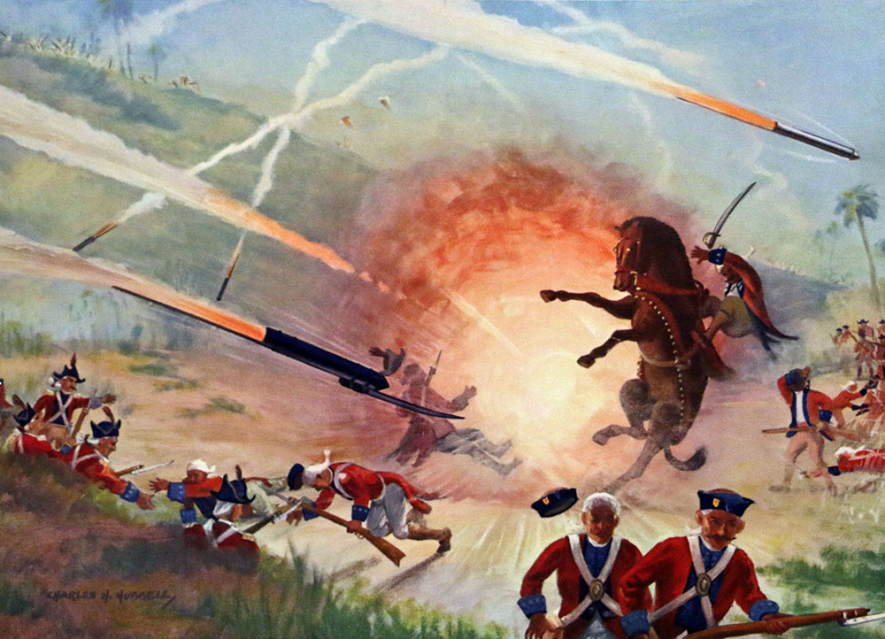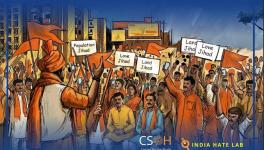Tipu Sultan’s Real History is Better Than the Fake One Being Peddled

East India Company confrontation with Mysorean rockets came in 1780 at the Battle of Guntur. The closely massed, normally unflinching East India Company troops broke and ran when the Mysorean Army laid down a rocket barrage in their midst. Image Courtesy: Wikimedia Commons
The British saw Tipu Sultan and Hyder Ali’s Mysore Kingdom as a significant obstacle to the British Empire in India. The British lost the first three Anglo-Mysore wars before defeating Tipu Sultan in the fourth. The British allies were the Nizam of Hyderabad and the Peshwas. Cutting to the present, the BJP’s battle against Tipu Sultan is limited—it is about the Karnataka elections. The attack on him is a not-so-thinly-veiled attack on Muslims. Since it is difficult to make heroes out of the British while vilifying Tipu Sultan, two Gowdas who allegedly fought and killed Tipu Sultan had to be invented. Tipu Sultan has to be defeated by Gowdas and not the British. That this incident figures in no history book or account of the fourth Anglo-Mysore War matters little to the BJP’s social media warriors—certainly not when winning the election in Karnataka is at stake.
What the BJP completely misses is that Hyder Ali and Tipu Sultan not only kept the British at bay for more than 30 years, they also significantly advanced rocketry beyond what existed anywhere at the time. The military significance of rockets had dwindled with the improvements to cannons. Rockets, compared with cannons, had a lower range and lacked accuracy. This is where Hyder Ali and Tipu Sultan’s advances in rocketry came in. Instead of using cardboard or wood as the casing of European rockets, Mysore rockets used iron casing for the body. This allowed more powder to be packed in the rocket, increasing its range and explosive power. Mysore rockets also used a long bamboo pole or sword tied to their ends to provide stability and injure enemy soldiers.
Under Hyder Ali and Tipu Sultan’s leadership, rockets became a major part of Mysore’s forces. The British Army found it difficult to combat the the Mysore forces’ massed rocket charges. They had not faced this kind of arms anywhere. Mysore’s rocket barrages led to the breaking up of the British formations and their defeat in the first three Anglo-Mysore wars. Only in the final battle in Seringapatam did the British finally prevail, in alliance with the Nizam and the Peshwas.
The American forces for independence were well aware of the British colonial wars. The Anglo-Mysore wars were part of the larger battle between France and England, in which the United States gained independence while India lost its freedom, becoming a British colony. The French aided the American War of Independence and allied with Mysore in India. American leaders regarded Mysore as an ally. In the naval battle of Delaware in 1812, one of its battleships was named Hyder Ally.
A part of the reason that Britain let the 13 colonies—the nucleus of the United States—win their freedom was they could no longer fight in both the Indian and North American theatres of war. They made a conscious decision about which colonies were more valuable for their Empire and which could be let go.
I will leave the history of the Anglo-Mysore wars and their significance to the historians and, instead, focus on rocketry and its importance. Remember it is rockets that take astronauts into space today and let us explore Mars and the moon, carry instruments to monitor monsoons, drought and weather phenomena like cyclones, and provide us with the signal for our TV at home. And, of course, rockets make weapons of all kinds, including the weapons of mass destruction, nuclear bombs. Science and technology are, unfortunately, inextricably linked to war and commerce. Rocketry is no exception.
So what did Tipu Sultan’s rockets do for the world? Roddam Narasimha, in his 1985 paper “Rockets in Mysore and Britain 1750-1850,” traces the history of Mysore rockets, the advances it made and its further course in the hands of the British. After the fall of Seringapatam, the British brought a number of rockets to Woolwich, where Britain's Royal Arsenal was located, to do what we now call reverse engineering. According to William Congreve, who was in charge of the rocketry project, “...the British at Seringapatam had suffered more from them [the rockets] than from the shells or any other weapon used by the enemy.” Congreve’s task was to see why the Mysore rockets were so much more effective than their European counterparts and create more advanced rockets for the British military.
Congreve left a series of papers and three books identifying why Mysore rockets were superior. He set out to improve them and standardise their production. For this contribution, they were widely known as Congreve rockets. He pointed out the benefits of using rockets over canons in naval bombardment. Unlike canon, rockets, when fired, have no recoil. This allowed ships to fire a larger number of volleys than if they used cannons. Also, while cannon balls were more accurate than rockets in land wars, rockets had the advantage that did not require heavy cannons to fire them. This made it easier to move them in battle and transport them over distances.
Roddam mentions Mysore could produce better quality iron than England could at that time. Though this is a separate history, South India had developed high-carbon steel—called wootz steel—outside India. (Wootz is possibly derived from the Telegu word for steel, ukku.) This was made using crucibles, and the resulting wootz balls were exported to Central and West Asia, from where they made their way into Europe. This is what gave rise to the famous Damascus blades, though similar blades were common in South India. The story of high-carbon steel and its use in Sheffield is a separate story and not directly linked to the development of the Congreve rockets.
Congreve rockets were widely used by the British against France, both in the continent and North America. Arthur Wellesley, later Duke Wellington and the victor in Waterloo, used rockets, as seen in pictures of the war painted at that time. The British also used Congreve’s rockets against United States forces in their Battle of Baltimore in 1812. The very first stanza of the United States’ national anthem, The Star-Spangled Banner, has the lines:
And the rockets’ red glare, the bombs bursting in air
Gave proof through the night that our flag was still there.
Not many people know that rockets here refer to Congreve rockets. Francis Scott Key, who penned these lines, was an American prisoner on a British ship and witnessed the bombardment of Fort McHenry in Baltimore, and therefore these lines. Of course, the anthem also glories about “freemen”, prescribing death to the slaves in the third stanza:
No refuge could save the hireling and slave
From the terror of flight, or the gloom of the grave.
It is because of the association of white supremacy and slavery with the Star-Spangled Banner that Black American athletes kneel in protest when it is sung, refusing to honour it by standing.
To end this story, when India’s rocket man APJ Abdul Kalam was visiting NASA’s Wallops Flight Facility, he discovered Tipu's pioneering contributions to rocketry. A painting of Tipu's use of rockets against the British is displayed in the main reception there. Real history is always more interesting than a manufactured one.
Get the latest reports & analysis with people's perspective on Protests, movements & deep analytical videos, discussions of the current affairs in your Telegram app. Subscribe to NewsClick's Telegram channel & get Real-Time updates on stories, as they get published on our website.























